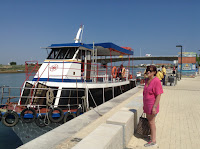Let me try the impossible - to
summarise personal impressions of Barcelona in a couple of pages. The opinions are based on two visits there in six
years.
“Barcelo-o-na,” as sung so exuberantly and
with such emphatic national fervour by the Catalonian capital’s operatic diva Monserrat Caballé in a duet with Freddie Mercury.
This was my
modernist operatic image of the city that hosted the 1992 Olympics, when BBC
television adopted the Queen song to introduce its coverage.
The exhilaration of the musical theme
heightened my anticipation of our first visit in early autumn 2010.
Emerging from our nearby hotel, helpfully located only about 100 metres off the city's main throughfare, my first
surprise was to encounter Las Ramblas heaving with
people. This, after all was a midweek in October.
After viewing the city from the nearby
portside Columbus Monument, an American tourist informed me that today was a public
holiday marking the discovery of America.
I had begun to wonder that if these crowds are typical of autumn, what
must the peak of summer be like.
Las Ramblas has the air of a permanent
carnival. There are countless stands and kiosks,
some selling exotic flowers, others selling assorted fluffy pets. “Living sculptures” abound. Barcelona takes mime artistry to a sublime
level.
Not content with standing
statuesquely and faces painted to match elaborate and colourful outfits, most
of the city’s street artists play for laughs and obligingly pose for
photographs. One had squeezed herself
into a baby’s stroller making jocular squeaking noises, another hid beneath a
table from which three heads - only one of which was his (or hers) - protruded
like grotesque gargoyles.
The Picasso museum comprehensively traces the development of
the artist’s style ranging from conventional art of his youth to the more
abstract style of his later years.
I
loved the use of photographic technology to demonstrate his reworking of the
Velazquez masterpiece Las Meninas. Zooming in, section by section, the slideshow
superimposed Picasso’s swishing brushstrokes over the classic original, much to
everybody’s amusement.
We go to see Bizet’s Carmen in the Liceu Opera House. The renowned tenor, Roberto Alagna is the
leading male in a modern and risqué production. It includes 11 Mercedes cars; a naked male
singer grabs our attention; and a voluptuous Carmen unzips the leading man’s
trousers. All done in the best possible
taste as sleek contemporary style meets classical genius.
Gaudi is the pervading influence. In bright autumnal sunshine, we tour the city
on an open top bus.
His “expiatory”
cathedral, the Sagrada
Familia, is a hectic building site (and still is when we return in September
2016).
Sparks fly from celestial heights
as teams of artisans work furiously. A
Papal visit beckons.
A century ago,
Gaudi steadfastly refused to give a deadline because (and I love this quotation),
“my client is not in a hurry.” Mi Dios.
Park Guell sees Gaudi’s riotous imagination at its creative best - buildings eschewing
straight lines and features embellished with fairyland ornamentation. The
very entrance pavilions look like wholesome and tasty gingerbread concoctions.
It is only after the event that the impact of
our visit sinks in.
My impression is that Barcelona likes to shock to impress. Gaudi’s architecture, the development of Picasso’s art, the radical production of Carmen, the Ramblas entertainers - all break the rules and conventions.
My impression is that Barcelona likes to shock to impress. Gaudi’s architecture, the development of Picasso’s art, the radical production of Carmen, the Ramblas entertainers - all break the rules and conventions.
Perhaps Barcelona is motivated by an
unstoppable urge to emphasise its own identity and to differentiate itself from
Castilian Spain. The result is fantastical creativity, innovation, and joy for
cultural tourists.
Five days is too little time but it gave my
wife and I a good excuse to return.
In 2010, our accommodation was a boutique
hotel on a side street off Las Ramblas. In 2016, we were self-catering in an
apartment[i] which
overlooked the Sagrada Familia Cathedral. You could almost reach out from the balcony and touch the Cathedral's spires.
On this second visit, we were accompanied by our youngest daughter, her husband and their two-year-old son. A wedding reception in an edge-of-city historic house awaited.
Despite the proximity to the always-popular cathedral, it is reassuring to know that dining out in such a locality is not always dominated by tourists. We found two top-quality[ii] and good-value restaurants[iii] serving Catalonian cuisine, frequented by local people and located very close to our apartment.
I would recommend one book.
The award-winning author of bestselling
novels like Nora Webster, The Testament of Mary, and Brooklyn is Colm
Tóibín. He has also written what is,
arguably, the definitive book about the city and region, “Homage to
Barcelona.”
©Michael McSorley 2016




















